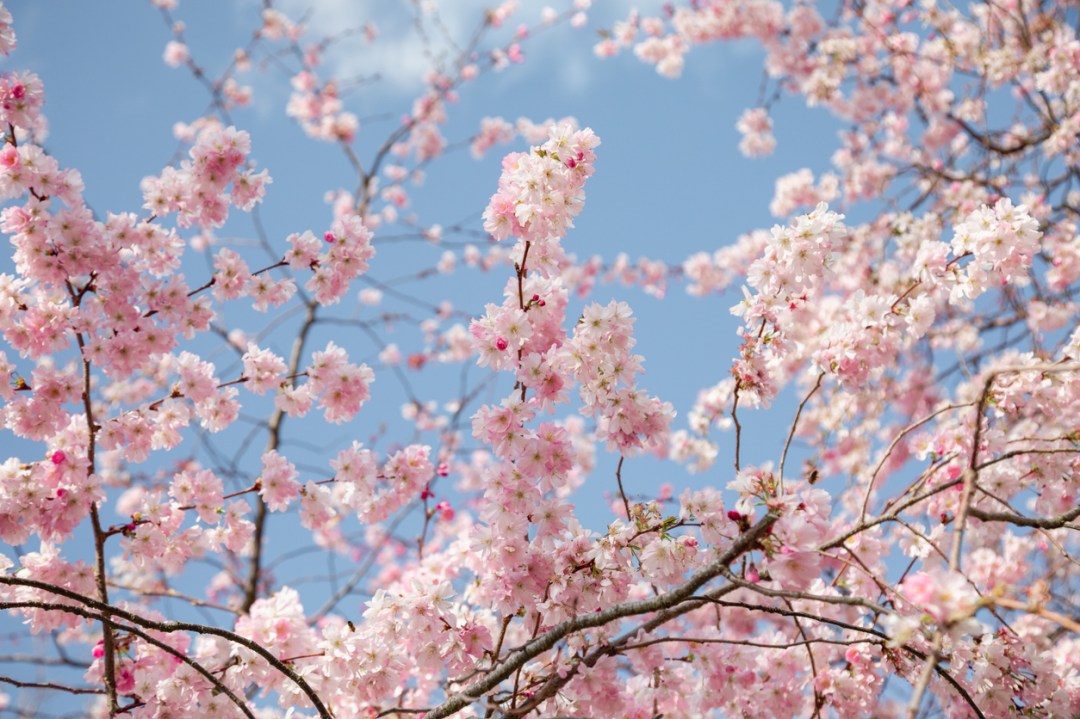It’s cherry blossom season in Japan and about half the population (according to a Kansai University study) will gather at the viewing spots to pose for photos (Japanese Instagram may collapse) and enjoy picnics in the shade of the sakura trees. Japan will also welcome close to four million visitors to witness the floral marvel. The season is brief, peaking in about a week and disappearing by the end of April, during which time the progress of the blooms across the country is followed with breathless enthusiasm by reporters on the news bulletins.
We are assumed to be, expected to be, giddy with excitement about all this, and to swoon with childlike wonder at the profusion of vivid yet delicate flowers. But I’m afraid I’m not quite up to it any more. After 25 years of dutiful attendances, the bloom is off the sakura for me and I’m beginning to find it all a bit of a bore. Frankly, I’m all cherried out.
For one thing, there is the sheer monotony. The pink-hued monoculture induces a feeling of mild nausea after a few minutes, while the white ones make me feel I’ve been struck with snow blindness. It’s all a bit too cute, too Disney. There is even something a tad disturbing about the relentless, artificially created uniformity – rows of identical trees planted with mathematical precision like hairs on a doll’s head. I’m reminded of those mass games in North Korea where everyone holds up cards to create a giant picture.
Then there are the reactions, from the Japanese at least, who accompany the manic photography (don’t forget the peace sign!) with the single word kirei (pretty) intoned like a mantra. Japanese is a bit light on adjectives and, unlike English, doesn’t crave substitution. After a few hours crawling along amid the selfie-snapping multitudes from one spot to another very similar spot, and a thousand repetitions of ‘kirei’, I start to get dark thoughts.
I think what I most object to, though, is the sheer obligation one feels to go along with the supposed rapture – that to demur (‘I’m a bit bored, actually’) would be to commit the gravest of cultural faux pas. And it really would be: while working at the British Council in Tokyo, which is opposite a cherry blossom tree-lined canal, I took part in a meeting where the Japanese manager looked out of the window and pronounced the view to be sublime. Another manager, English, remarked that it was ‘the same every bloody year’. The Japanese manager looked crestfallen and bewildered, like he had just torn up the Japanese flag in front of her.
I also get a little tired of hearing how sublimely, essentially, profoundly Japanese it all is – as if cherry blossoms exist only in Japan and only the natives truly appreciate them. In Japanese folk religions, sakura spots were believed to be dwelling places of mountain deities, thus pilgrims would travel great distances to pay homage. The viewing party tradition, a sort of secular continuation of the pilgrimages, goes back to the Nara period (710–794), apparently. The sakura image is central to Japanese ideography from ukiyo-e (traditional painting) to anime. Samurai used cherry blossoms as emblems of their strict moral code; kamikaze pilots painted sakura on their planes, and today the image is ubiquitous and more emblematic of the country (see Visit Japan’s promotional material) than the actual official flower, the chrysanthemum.
I’m beginning to find it all a bit of a bore. Frankly, I’m all cherried out
This is all very well but, like sakura mochi (a gooey sakura-flavoured sweet), a little hard to swallow. The Japanese have not always been the best custodians of their horticultural heritage. Consider the story of Collingwood ‘Cherry’ Ingram – the man who saved Japan’s cherry blossoms. Ingram was an English naturalist credited with saving a variety of Japanese cherry blossom and reintroducing it to Japan. It seems that in the early 19th century, varieties were dying out through neglect and the dominance of, in the words of Ingram’s biographer Naoko Abe, ‘a dangerous creeping ideology’ which promoted a cloning cherry – somei-yoshino – associated with Japan’s then expansionist policies, at the expense of natural diversity.
There is a dark side to those cherry blossom parties too. The most prestigious events have allegedly been used by unscrupulous politicians for a bit of hard grifting, with extravagant treats doled out to favoured supporters. Had Japan’s longest-serving prime minister, Shinzo Abe, not been assassinated in 2022, he may have faced serious consequences for similar allegations. He was accused of treading supporters to heavily subsidised meals at top hotels on the eve of cherry blossom party events.
However, if all this sounds a bit grouchy and disrespectful, I do appreciate the tradition and would hate to see it disappear. And it seems I am not entirely alone in my grouchiness: a survey reported in the Mainichi newspaper in 2024 revealed that 60 per cent of Japanese attendees at cherry blossom parties would rather be somewhere else. The most common complaint was that the parties were considered to be ‘work’. Which in a sense they are – the hard work of upholding the traditions and maintaining the myths that foster national identity, social cohesion and societal harmony. Just include me out.








Comments